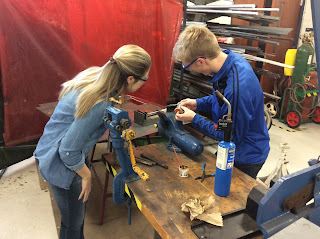Problem Solving: The New Type of Thinking
Problem solving is such a useful concept that often gets overlooked. When I say problem solving I don't necessarily mean what is the answer to 2+2 but a more in depth look into the "why," "what," and "how" type questions. Agricultural Education allows for a unique perspective on problem solving, for real world situations. This week as a class we were able to discuss some "real-life" uses of problem solving in an agricultural classroom that truly put things into perspective. Problem solving has a wide array of uses in agriculture from deciding what plant would make a better cover crop to determine which animals to cull out of a herd.
To ensure an effective use of problem solving I have found that there some specific techniques that should be followed.
Scaffolding. We have already looked into why scaffolding is an important teaching technique overall but it can be equally beneficial when using problem solving in the classroom. Scaffolding can be preformed by providing students with a problem, goal, and the strategies for solving the problem. The implementation of how the problem is conducted can very depending on is the problem or goal is provided first, allowing students to use different ways of thinking.
Knowledge. The problems should be based around the students already know or knowledge you wish they obtain. It's important to make problems challenging to encourage students think and stretch knowledge they already have. However, if the problem appears to challenging the students may feel defeated. There should be a middle ground on what knowledge your students have and what you hope they achieve.
Reflection. Until developing an understanding for reflection recently, I never knew the power that it can have on a students learning. Reflection is a truly powerful teaching method to understand if the students are obtaining the material being taught. When it comes to problem solving specifically, it is important to understand why the answer was the way it was or even why students chose the answer that they did.
The list of methods for conducting problem solving can be almost endless as they must meet the needs of your students. I found this resource on effective Problem Solving to be extremely beneficial as it pertains to agricultural education.
I look forward to continuing to develop a competency for problem solving in the class room and conducting it in my future classrooms. I believe effective problem solving creates a whole new level of learning that will be extremely beneficial for students beyond the classroom.
________________________________________________________________________________________________
To ensure an effective use of problem solving I have found that there some specific techniques that should be followed.
Scaffolding. We have already looked into why scaffolding is an important teaching technique overall but it can be equally beneficial when using problem solving in the classroom. Scaffolding can be preformed by providing students with a problem, goal, and the strategies for solving the problem. The implementation of how the problem is conducted can very depending on is the problem or goal is provided first, allowing students to use different ways of thinking.
Knowledge. The problems should be based around the students already know or knowledge you wish they obtain. It's important to make problems challenging to encourage students think and stretch knowledge they already have. However, if the problem appears to challenging the students may feel defeated. There should be a middle ground on what knowledge your students have and what you hope they achieve.
Reflection. Until developing an understanding for reflection recently, I never knew the power that it can have on a students learning. Reflection is a truly powerful teaching method to understand if the students are obtaining the material being taught. When it comes to problem solving specifically, it is important to understand why the answer was the way it was or even why students chose the answer that they did.
The list of methods for conducting problem solving can be almost endless as they must meet the needs of your students. I found this resource on effective Problem Solving to be extremely beneficial as it pertains to agricultural education.
I look forward to continuing to develop a competency for problem solving in the class room and conducting it in my future classrooms. I believe effective problem solving creates a whole new level of learning that will be extremely beneficial for students beyond the classroom.
________________________________________________________________________________________________
Phipps, L.J., Osborn, E.W., Dyer, J.E., & Ball, A.L. (2008) Handbook on agricultural education in public schools, 1st Edition. Boston, MA: Cengage Learning.
Kirkley, J. (2003). Principles for teaching problem solving. Retrieved from


Comments
Post a Comment